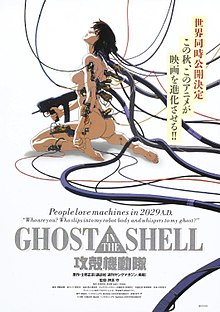| Ghost in the Shell | |||||
|---|---|---|---|---|---|
 Theatrical release poster | |||||
| Japanese name | |||||
| Kanji | GHOST IN THE SHELL/攻殻機動隊 | ||||
| |||||
| Directed by | Mamoru Oshii | ||||
| Screenplay by | Kazunori Itō | ||||
| Based on | Ghost in the Shell by Masamune Shirow | ||||
| Produced by |
| ||||
| Starring | |||||
| Cinematography | Hisao Shirai | ||||
| Edited by |
| ||||
| Music by | Kenji Kawai | ||||
Production companies | |||||
| Distributed by | |||||
Release dates |
| ||||
Running time | 83 minutes[2] | ||||
| Countries | |||||
| Language | Japanese | ||||
| Budget | ¥330 million ($3 million[5]) | ||||
| Box office | $10 million[6] | ||||
Ghost in the Shell[a] is a 1995 adult animated tech noir cyberpunk action thriller film[8][9] directed by Mamoru Oshii and adapted by frequent Oshii collaborator Kazunori Itō. The film is based on the manga of the same name by Masamune Shirow. It stars the voices of Atsuko Tanaka, Akio Ōtsuka, and Iemasa Kayumi. It is a Japanese-British international co-production between Kodansha, Bandai Visual and Manga Entertainment, with animation provided by Production I.G.
The film is set in 2029 in the fictional New Port City and follows Motoko Kusanagi, a cyborg public-security agent, who hunts an enigmatic hacker/ghost known as the Puppet Master. The narrative incorporates philosophical themes that focus on self-identity in a technologically advanced world. The music, composed by Kenji Kawai, includes vocals in classical Japanese. The film's visuals were created through a combination of traditional cel animation and CGI animation.
Upon release, Ghost in the Shell received positive reviews, with critics praising its narrative, visuals, and musical score. The film was initially considered a box-office failure before developing a cult following on home video. Since then, it has grown in esteem and is now considered to be one of the greatest anime and science-fiction films of all time.[10][11][12] It inspired filmmakers such as The Wachowskis, creators of The Matrix franchise, with James Cameron describing it as "the first truly adult animation film to reach a level of literary and visual excellence."[13] The film received numerous accolades and was nominated in five categories—including Best Animated Feature—at the 24th Annie Awards, making it the most nominations for a Japanese animated film at the Annie Awards; both The Boy and the Heron and Suzume took over the position with seven at the 51st Annie Awards.
An updated version of the film, Ghost in the Shell 2.0, was released in 2008, featuring newly added digital effects, additional 3D animation and new audio. Oshii directed Ghost in the Shell 2: Innocence, released in 2004, which was billed as a separate work and a non-canonical sequel.
- ^ "Production I.G [WORK LIST]". Production I.G. Archived from the original on 26 December 2018. Retrieved 29 December 2018.
- ^ a b "GHOST IN THE SHELL (15)". British Board of Film Classification. 30 October 1995. Archived from the original on 6 April 2015. Retrieved 28 January 2015.
- ^ "Kokaku kidotai (1995)". British Film Institute. London. Archived from the original on 31 July 2017. Retrieved 10 February 2017.
- ^ Sevakis, Justin (14 September 2015). "What Ever Happened to Manga Entertainment?". Answerman (column). Anime News Network. Archived from the original on 22 July 2018. Retrieved 10 February 2017.
- ^ Harding, Daryl (19 September 2021). "Ghost in the Shell Producer Confirms How Much the 1995 Anime Film Cost to Make". Crunchyroll. Archived from the original on 19 September 2021. Retrieved 19 September 2021.
- ^ Cite error: The named reference
crunchyrollwas invoked but never defined (see the help page). - ^ "『Ghost in the Shell/攻殻機動隊』 4Kリマスターセット (4K ULTRA HD Blu-ray&Blu-ray Disc 2枚組) | 商品詳細" (in Japanese). Bandai Visual. Archived from the original on 16 October 2019. Retrieved 3 April 2021.
- ^ "IMAX: Ghost in the Shell (15)". National Science and Media Museum. Archived from the original on 13 September 2021. Retrieved 13 September 2021.
- ^ See, Raphael. "Ghost in the Shell". THEM Anime Reviews. Archived from the original on 12 August 2020. Retrieved 26 February 2023.
- ^ "The Best Animated Movies of All Time". Complex. Archived from the original on 20 May 2021. Retrieved 9 June 2021.
- ^ "Why is Ghost in the Shell (1995) sometimes labeled the greatest and most philosophical anime ever made?". South China Morning Post. 6 December 2019. Archived from the original on 9 June 2021. Retrieved 9 June 2021.
- ^ "10 Best Anime Movies (That You Can Stream For Free Online)". ScreenRant. 7 June 2021. Archived from the original on 9 June 2021. Retrieved 9 June 2021.
- ^ "10 Important Anime Films That Had Worldwide Success". ScreenRant. 3 May 2021. Archived from the original on 9 June 2021. Retrieved 9 June 2021.
Cite error: There are <ref group=lower-alpha> tags or {{efn}} templates on this page, but the references will not show without a {{reflist|group=lower-alpha}} template or {{notelist}} template (see the help page).